Revealing the Driving Mechanisms of Land Surface Temperature Spatial Heterogeneity and Its Sensitive Regions in China Based on GeoDetector
Abstract
1. Introduction
2. Materials
2.1. Satellite Products
2.2. Reanalysis Data
2.3. Climate Type Data
3. Methods
3.1. GeoDetector
3.1.1. Factor Detector
3.1.2. Interaction Detector
3.1.3. Risk Detector
3.2. Data Discretization Methods
4. Results
4.1. Data Discretization
4.2. Selection of Optimal Spatial Unit Scale
4.3. Impact of Individual Factor on the Spatial Heterogeneity of LST
4.4. Effect of the Joint Factor on the Spatial Heterogeneity of LST
4.5. Determine the Regions of the LST That Are Vulnerable to Drivers
5. Discussions
6. Conclusions
- (1)
- The factor detector showed that the explanatory ability of the drivers (TA, WV, CLIMATE, DEM, AOD, RN, NDVI, PRE, ET, and SM) indicates that TA has the greatest driving effect in the selected years, and the driving strength is increasing at a rate of 0.003/year. WV is second only to TA and also shows a strong driving effect on LST spatial heterogeneity with a change rate of 0.004/year. LULC has no driving effect on LST spatial heterogeneity due to the spatial unit scale.
- (2)
- The interaction detector revealed that the effect of the interaction is significantly greater than the effect of any single factor, which indicates that the spatial heterogeneity of LST is the result of multi-factor interactions. Similarly to the individual effect, TA has the strongest joint effect with other factors, especially the interaction with LULC, with a mean q-value of 0.78.
- (3)
- The risk detector found that the sensitive areas of LST determined by the driving factor have a similar spatial distribution pattern. However, variations in the high-sensitivity regions exist from year to year. During the study period, LST was driven by AOD over the widest area, with an average share of 15.8%, followed by WV, with an average share of 11.5%. Overall, the high-sensitivity areas determined by most drivers showed a decreasing trend.
Author Contributions
Funding
Data Availability Statement
Acknowledgments
Conflicts of Interest
References
- Townshend, J.R.G.; Justice, C.O.; Skole, D.; Malingreau, J.P.; Cihlar, J.; Teillet, P.; Sadowski, F.; Ruttenberg, S. The 1 km resolution global data set: Needs of the International Geosphere Biosphere Programme. Int. J. Remote Sens. 1994, 15, 3417–3441. [Google Scholar] [CrossRef]
- Anderson, M.; Norman, J.; Kustas, W.; Houborg, R.; Starks, P.; Agam, N. A thermal-based remote sensing technique for routine mapping of land-surface carbon, water and energy fluxes from field to regional scales. Remote Sens. Environ. 2008, 112, 4227–4241. [Google Scholar] [CrossRef]
- Zhang, Q.; Xu, C.Y.; Zhang, Z.; Chen, Y.D. Changes of temperature extremes for 1960–2004 in Far-West China. Stoch. Environ. Res. Risk Assess. 2008, 23, 721–735. [Google Scholar] [CrossRef]
- Li, Z.-L.; Tang, B.-H.; Wu, H.; Ren, H.; Yan, G.; Wan, Z.; Trigo, I.F.; Sobrino, J.A. Satellite-derived land surface temperature: Current status and perspectives. Remote Sens. Environ. 2013, 131, 14–37. [Google Scholar] [CrossRef]
- Karnieli, A.; Agam, N.; Pinker, R.; Anderson, M.; Imhoff, M.; Gutman, G.; Panov, N.; Goldberg, A. Use of NDVI and land surface temperature for drought assessment: Merits and limitations. J. Clim. 2010, 23, 618–633. [Google Scholar] [CrossRef]
- Peng, W.; Zhou, J.; Wen, L.; Xue, S.; Dong, L. Land surface temperature and its impact factors in Western Sichuan Plateau, China. Geocarto Int. 2016, 32, 919–934. [Google Scholar] [CrossRef]
- Zhao, H.; Ren, Z.; Tan, J. The spatial patterns of land surface temperature and its impact factors: Spatial non-stationarity and scale effects based on a Geographically-Weighted Regression model. Sustainability 2018, 10, 2242. [Google Scholar] [CrossRef]
- Guha, S.; Govil, H.; Diwan, P. Monitoring LST-NDVI relationship using premonsoon Landsat datasets. Adv. Meteorol. 2020, 2020, 4539684. [Google Scholar] [CrossRef]
- Yang, Y.; Park, J.; An, S.; Wang, B.; Luo, X. Mean sea surface temperature changes influence ENSO-related precipitation changes in the mid-latitudes. Nat. Commun. 2021, 12, 1495. [Google Scholar] [CrossRef]
- Juang, J.Y.; Katul, G.; Siqueira, M.; Stoy, P.; Novick, K. Separating the effects of albedo from eco-physiological changes on surface temperature along a successional chrono sequence in the southeastern United States. Geophys. Res. Lett. 2007, 34, 1–5. [Google Scholar] [CrossRef]
- Peng, S.S.; Piao, S.; Zeng, Z.; Ciais, P.; Zhou, L.; Li, L.Z.; Myneni, R.B.; Yin, Y.; Zeng, H. Afforestation in China cools local land surface temperature. Proc. Natl. Acad. Sci. USA 2014, 111, 2915–2919. [Google Scholar] [CrossRef] [PubMed]
- Liu, Y.; Zhang, Y.; Zhu, J.; Huang, K.; Zu, J.; Chen, N.; Cong, N.; Stegehuis, A. Warming slowdown over the Tibetan plateau in recent decades. Theor. Appl. Climatol. 2018, 135, 1375–1385. [Google Scholar] [CrossRef]
- Feng, Y.; Gao, C.; Tong, X.; Chen, S.; Lei, Z.; Wang, J. Spatial patterns of land surface temperature and their influencing factors: A case study in Suzhou, China. Remote Sens. 2019, 11, 182. [Google Scholar] [CrossRef]
- Zhou, W.Q.; Husng, G.L.; Cadenasso, M.L. Does spatial configuration matter? Understanding the effects of land cover pattern on land surface temperature in urban landscapes. Landsc. Urban Plan 2011, 102, 54–63. [Google Scholar] [CrossRef]
- Yan, Y.; Mao, K.; Shi, J.; Piao, S.; Shen, X.; Dozier, J.; Liu, Y.; Ren, L.-H.; Bao, Q. Driving forces of land surface temperature anomalous changes in North America in 2002–2018. Sci. Rep. 2020, 10, 6391. [Google Scholar] [CrossRef]
- Zhi, Y.; Shan, L.; Ke, L.; Yang, R. Analysis of Land Surface Temperature Driving Factors and Spatial Heterogeneity Research Based on Geographically Weighted Regression Model. Complexity 2020, 2020, 2862917. [Google Scholar] [CrossRef]
- Yu, Y.; Shang, G.; Duan, S.; Yu, W.; Labed, J.; Li, Z. Quantifying the Influences of Driving Factors on Land Surface Temperature during 2003–2018 in China Using Convergent Cross Mapping Method. Remote Sens. 2022, 14, 3280. [Google Scholar] [CrossRef]
- Brunsdon, C.; Fotheringham, A.S.; Charlton, M.E. Geographically weighted regression: A method for exploring spatial nonstationarity. Geogr. Anal. 1996, 28, 281–298. [Google Scholar] [CrossRef]
- Goovaerts, P.; Xiao, H.; Adunlin, G.; Ali, A.; Tan, F.; Gwede, C.K.; Huang, Y. Geographically-weighted regression analysis of percentage of late-stage prostate cancer diagnosis in florida. Appl. Geogr. 2015, 62, 191–200. [Google Scholar] [CrossRef]
- Zhao, Z.; Gao, J.; Wang, Y.; Liu, J.; Li, S. Exploring spatially variable relationships between NDVI and climatic factors in a transition zone using geographically weighted regression. Theor. Appl. Climatol. 2015, 120, 507–519. [Google Scholar] [CrossRef]
- Javi, S.T.; Malekmohammadi, B.; Mokhtari, H. Application of geographically weighted regression model to analysis of spatiotemporal varying relationships between groundwater quantity and land use changes (case study: Khanmirza Plain, Iran). Environ. Monit. Assess. 2014, 186, 3123–3138. [Google Scholar] [CrossRef] [PubMed]
- Zhou, X.; Wang, Y. Dynamics of land surface temperature in response to land-use/cover change. Geogr. Res. 2010, 49, 23–36. [Google Scholar] [CrossRef]
- Li, S.; Zhao, Z.; Miao, X.; Wang, Y. Investigating spatial non-stationary and scale-dependent relationships between urban surface temperature and environmental factors using geographically weighted regression. Environ. Model. Softw. 2010, 25, 1789–1800. [Google Scholar] [CrossRef]
- Szymanowski, M.; Kryza, M. Application of geographically weighted regression for modelling the spatial structure of urban heat island in the city of Wroclaw (SW Poland). Procedia Environ. Sci. 2011, 3, 87–92. [Google Scholar] [CrossRef]
- Ivajnšič, D.; Kaligarič, M.; Žiberna, I. Geographically weighted regression of the urban heat island of a small city. Appl. Geogr. 2014, 53, 41–353. [Google Scholar] [CrossRef]
- Wang, J.F.; Zhang, T.L.; Fu, B.J. A measure of spatial stratified heterogeneity. Ecol. Indic. 2016, 67, 250–256. [Google Scholar] [CrossRef]
- Yang, D.; Wang, X.; Xu, J.; Xu, C.; Lu, D.; Ye, C.; Wang, Z.; Bai, L. Quantifying the influence of natural and socioeconomic factors and their interactive impact on PM2.5 pollution in China. Environ. Pollut. 2018, 241, 475–483. [Google Scholar] [CrossRef]
- Luo, W.; Jasiewicz, J.; Stepinski, T.; Wang, J.; Xu, C.; Cang, X. Spatial association between dissection density and environmental factors over the entire conterminous United States. Geophys. Res. Lett. 2016, 43, 692–700. [Google Scholar] [CrossRef]
- Wang, W.; Samat, A.; Abuduwaili, J.; Ge, Y. Spatio-temporal variations of satellite-based PM2.5 concentrations and its determinants in Xinjiang, northwest of China. Int. J. Environ. Res. Public Health 2020, 17, 2157. [Google Scholar] [CrossRef]
- Yang, J.; Ren, J.; Sun, D.; Xiao, X.; Xia, J.; Jin, C.; Li, X. Understanding land surface temperature impact factors based on local climate zones. Sustain. Cities Soc. 2021, 69, 102818. [Google Scholar] [CrossRef]
- Wu, Z.; Man, W.; Ren, Y. Detection of spatial-temporal variations in forest canopy surface temperature in response to urbanization: A case study from Longyan, China. J. Environ. Plan. Manag. 2019, 63, 1283–1300. [Google Scholar] [CrossRef]
- Chen, L.; Wang, X.; Cai, X.; Yang, C.; Lu, X. Seasonal variations of daytime land surface temperature and their underlying drivers over Wuhan, China. Remote Sens. 2021, 13, 323. [Google Scholar] [CrossRef]
- Wang, J.; Zhao, J.; Zhou, P.; Li, K.; Cao, Z.; Zhang, H.; Han, Y.; Luo, Y.; Yuan, X. Study on the Spatial and Temporal Evolution of NDVI and Its Driving Mechanism Based on Geodetector and Hurst Indexes: A Case Study of the Tibet Autonomous Region. Sustainability 2023, 15, 5981. [Google Scholar] [CrossRef]
- Wan, Z.; Li, Z.-L. A physics-based algorithm for retrieving land-surface emissivity and temperature from EOS/MODIS data. IEEE Trans. Geosci. Remote Sens. 1997, 35, 980–996. [Google Scholar] [CrossRef]
- Wan, Z.; Zhang, Y.; Zhang, Q.; Li, Z.L. Validation of the land-surface temperature products retrieved from Terra Moderate Resolution Imaging Spectroradiometer data. Remote Sens. Environ. 2002, 83, 163–180. [Google Scholar] [CrossRef]
- Wan, Z.; Li, Z.-L. Radiance-based validation of the V5 MODIS land surface temperature product. Int. J. Remote Sens. 2008, 29, 5373–5395. [Google Scholar] [CrossRef]
- Wan, Z.; Li, Z.-L. MODIS land surface temperature and emissivity. In Land Remote Sensing and Global Environmental Change; Springer: Berlin/Heidelberg, Germany, 2010; pp. 563–577. [Google Scholar]
- Carlson, T.N.; Ripley, D.A. On the relation between NDVI, fractional vegetation cover, and leaf area index. Remote Sens. Environ. 1997, 62, 241–252. [Google Scholar] [CrossRef]
- Chen, Y.; Xia, J.; Liang, S.; Feng, J.; Fisher, J.B.; Li, X.; Li, X.; Liu, S.; Ma, Z.; Miyata, A. Comparison of satellite-based evapotranspiration models over terrestrial ecosystems in China. Remote Sens. Environ. 2014, 140, 279–293. [Google Scholar] [CrossRef]
- Dorigo, W.; Wagner, W.; Albergel, C.; Albrecht, F.; Balsamo, G.; Brocca, L.; Chung, D.; Ertl, M.; Forkel, M.; Gruber, A. ESA CCI Soil Moisture for improved Earth system understanding: State-of-the art and future directions. Remote Sens. Environ. 2017, 203, 185–215. [Google Scholar] [CrossRef]
- Liu, Y.Y.; Dorigo, W.A.; Parinussa, R.M.; DeJeu, R.A.M.; Wagner, W.; McCabe, M.F.; Evans, J.P.; Van Dijk, A.I.J.M. Trend-preserving blending of passive and active microwave soil moisture retrievals. Remote Sens. Environ. 2012, 123, 280–297. [Google Scholar] [CrossRef]
- An, R.; Zhang, L.; Wang, Z.; Quaye-Ballard, J.A.; You, J.; Shen, X.; Gao, W.; Huang, L.; Zhao, Y.; Ke, Z. Validation of the ESA CCI soil moisture product in China. Int. J. Appl. Earth Obs. Geoinf. 2016, 48, 28–36. [Google Scholar] [CrossRef]
- Albergel, C.; Dorigo, W.; Reichle, R.H.; Balsamo, G.; De Rosnay, P.; Munoz-Sabater, J.; Isaksen, L.; De Jeu, R.; Wagner, W. Skill and Global Trend Analysis of Soil Moisture from Reanalyses and Microwave Remote Sensing. J. Hydrometeorol. 2013, 14, 1259–1277. [Google Scholar] [CrossRef]
- Harris, I.; Osborn, T.J.; Jones, P.; Lister, D. Version 4 of the CRU TS monthly high-resolution gridded multivariate climate dataset. Sci. Data 2020, 7, 109. [Google Scholar] [CrossRef]
- Li, X.; Zhou, Y.; Asrar, G.R.; Zhu, Z. Developing a 1 km resolution daily air temperature dataset for urban and surrounding areas in the conterminous United States. Remote Sens. Environ. 2018, 215, 74–84. [Google Scholar] [CrossRef]
- Parker, J.; Kenyon, R.V.; Troxel, D.E. Comparison of interpolating methods for image resampling. IEEE Trans. Med. Imaging 1983, 2, 31–39. [Google Scholar] [CrossRef] [PubMed]
- Wang, J.; Li, X.H.; Christakos, G.; Liao, Y.; Zhang, T.; Gu, X.; Zheng, X. Geographical Detectors-Based Health Risk Assessment and its Application in the Neural Tube Defects Study of the Heshun Region, China. Int. J. Geogr. Inf. Sci. 2010, 24, 107–127. [Google Scholar] [CrossRef]
- Wang, J.; Hu, Y. Environmental health risk detection with GeoDetector. Environ. Model. Softw. 2012, 33, 114–115. [Google Scholar] [CrossRef]
- Liao, Y.L.; Wang, J.F.; Guo, Y.Q.; Zheng, X.Y. Risk Assessment of Human Neural Tube Defects Using a Bayesian Belief Network. Environ. Res. Risk Assess. 2010, 24, 93–100. [Google Scholar] [CrossRef]
- Kerber, R. Chimerge: Discretization of numeric attributes. In Proceedings of the Tenth National Conference on Artificial Intelligence, San Jose, CA, USA, 12–16 July 1992; AAAI Press: Menlo Park, CA, USA, 1992; pp. 123–128. [Google Scholar]
- Dougherty, J.; Kohavi, R.; Sahami, M. Supervised and unsupervised discretization of continuous features. In Proceedings of the Twelfth International Conference on Machine Learning, Tahoe City, CA, USA, 9–12 July 1995; Morgan Kaufmann Publisher: San Francisco, CA USA, 1995; pp. 194–202. [Google Scholar] [CrossRef]
- Kurgan, L.A.; Cios, K.J. Discretization algorithm that uses class-attribute interdependence maximization. IEEE Trans. Knowl. Data Eng. 2004, 16, 145153. [Google Scholar] [CrossRef]
- Tsai, C.J.; Lee, C.I.; Yang, W.P. A discretization algorithm based on Class-Attribute Contingency Coefficient. Inf. Sci. 2008, 178, 714–731. [Google Scholar] [CrossRef]
- Ge, Y.; Cao, F.; Duan, R.F. Impact of discretization methods on the rough set-based classification of remotely sensed images. Int. J. Digit. Earth 2011, 4, 330–346. [Google Scholar] [CrossRef]
- Fisher, M.M.; Wang, J.F. Spatial Data Analysis: Models, Methods and Techniques; Springer: Berlin, Germany, 2011; p. 82. [Google Scholar]
- Jenks, G.F. The data model concept in statistical mapping. Int. Yearb. Cartogr. 1967, 7, 186–190. [Google Scholar]
- Cao, F.; Ge, Y.; Wang, J. Optimal discretization for geographical detectors-based risk assessment. GISci. Remote Sens. 2013, 50, 78–92. [Google Scholar] [CrossRef]
- Roth, N.E.; David, A.J.; Erickson, D.L. Landscape influences on stream biotic integrity assessed at multiple spatial scales. Landsc. Ecol. 1996, 11, 141–156. [Google Scholar] [CrossRef]
- Store, R.; Jokimäki, J. A GIS-based multi-scale approach to habitat suitability modeling. Ecol. Model. 2003, 169, 1–15. [Google Scholar] [CrossRef]
- Chen, Q.; Mcroberts, R.; Wang, C.; Radtke, P. Forest aboveground biomass mapping and estimation across multiple spatial scales using model-based inference. Remote Sens. Environ. 2016, 184, 350–360. [Google Scholar] [CrossRef]
- Xu, Y.; Shen, Y.; Wu, Z. Spatial and temporal variations of land surface temperature over the Tibetan plateau based on harmonic analysis. Mt. Res. Dev. 2013, 33, 85–94. [Google Scholar] [CrossRef]
- Yang, M.; Zhao, W.; Zhan, Q.; Xiong, D. Spatiotemporal patterns of land surface temperature change in the Tibetan plateau based on MODIS/Terra daily product from 2000 to 2018. IEEE J. Sel. Top. Appl. Earth Obs. Remote Sens. 2021, 14, 6501–6514. [Google Scholar] [CrossRef]
- Xing, Z.; Yu, Y.; Duan, S.-B.; Li, Z.-L.; Gao, M.; Leng, P.; Shang, G. Modeling year-to-year variations of clear-sky land surface temperature using Aqua/MODIS data. IEEE Access 2020, 8, 114541–114553. [Google Scholar] [CrossRef]
- Yu, Y.; Duan, S.; Li, Z.; Chang, S.; Xing, Z.; Leng, P.; Gao, M. Interannual spatiotemporal variations of land surface temperature in China from 2003 to 2018. IEEE J. Sel. Top. Appl. Earth Obs. Remote Sens. 2021, 14, 1783–1795. [Google Scholar] [CrossRef]
- Xu, Y.; Knudby, A.; Shen, Y.; Liu, Y. Mapping monthly air temperature in the Tibetan Plateau from MODIS data based on machine learning methods. IEEE J. Sel. Top. Appl. Earth Obs. Remote Sens. 2018, 11, 345–354. [Google Scholar] [CrossRef]
- Gttsche, F.M.; Olesen, F.S. Modelling the effect of optical thickness on diurnal cycles of land surface temperature. Remote Sens. Environ. 2009, 113, 2306–2316. [Google Scholar] [CrossRef]
- Zhang, W.; Yi, S.-H.; Qin, Y.; Shangguan, D.-H.; Qin, Y. Analysis of features and influencing factors of alpine meadow surface temperature based on UAV thermal thermography. Acta Prataculturae Sin. 2021, 30, 15–27. [Google Scholar]
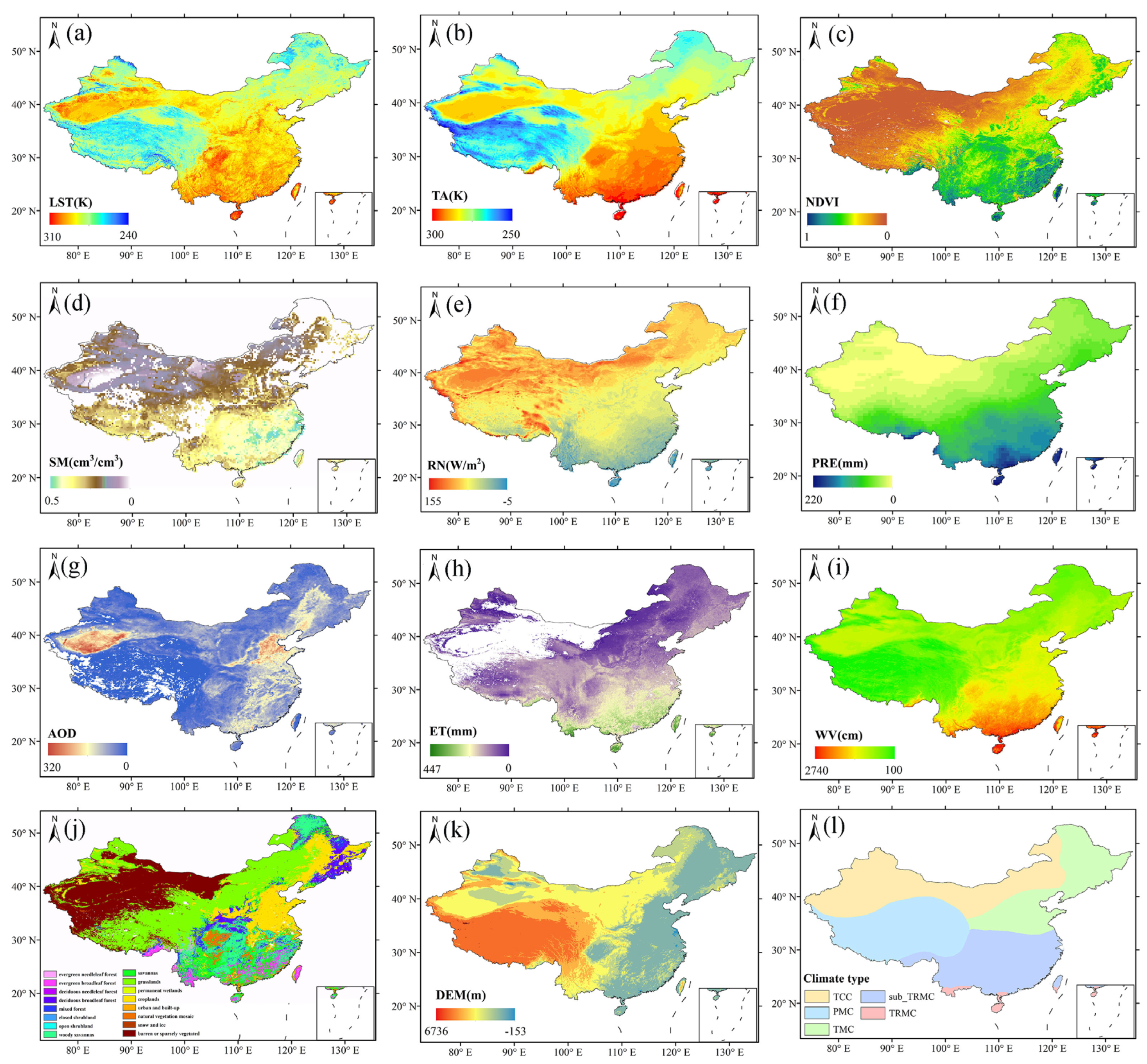
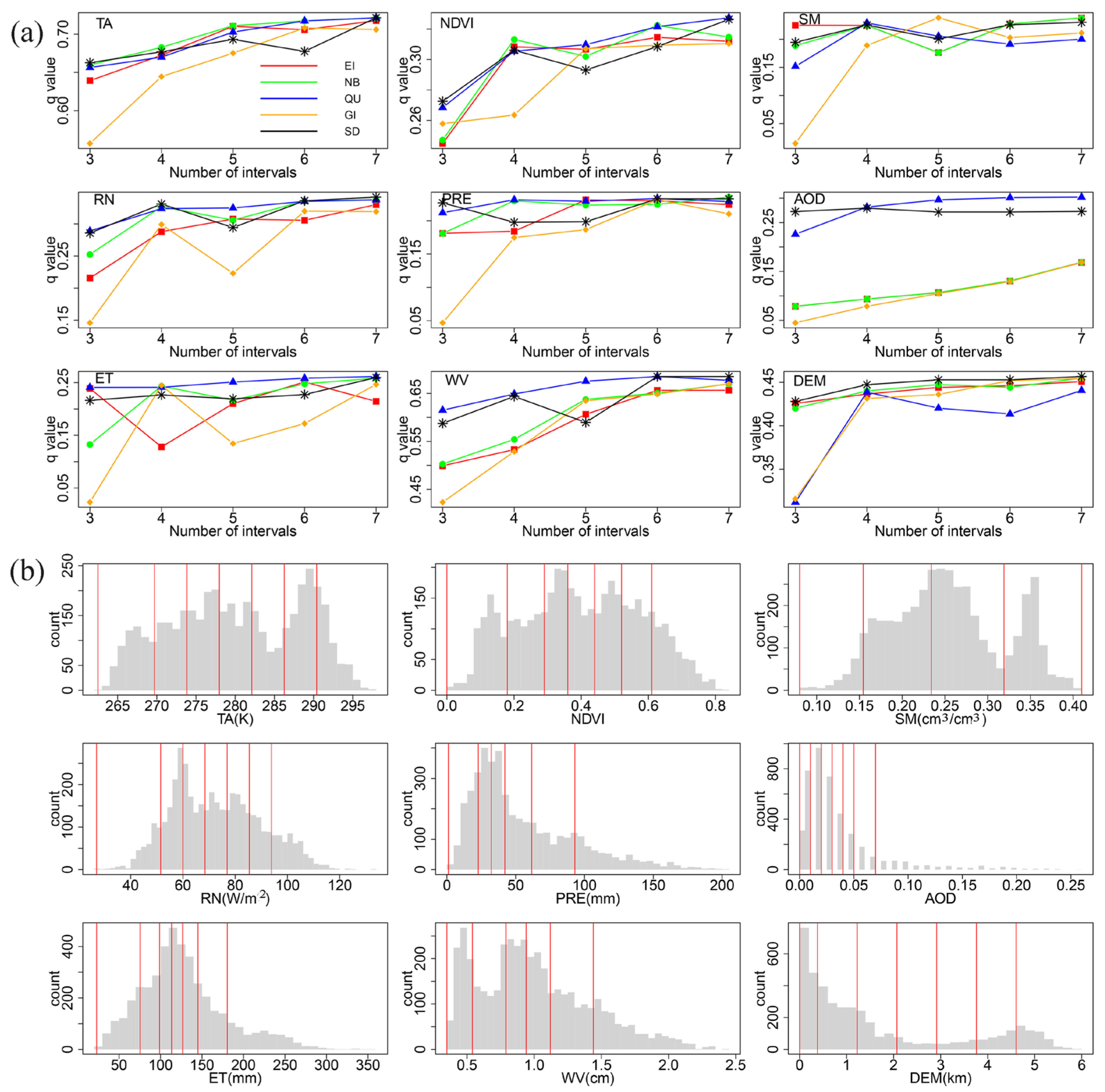
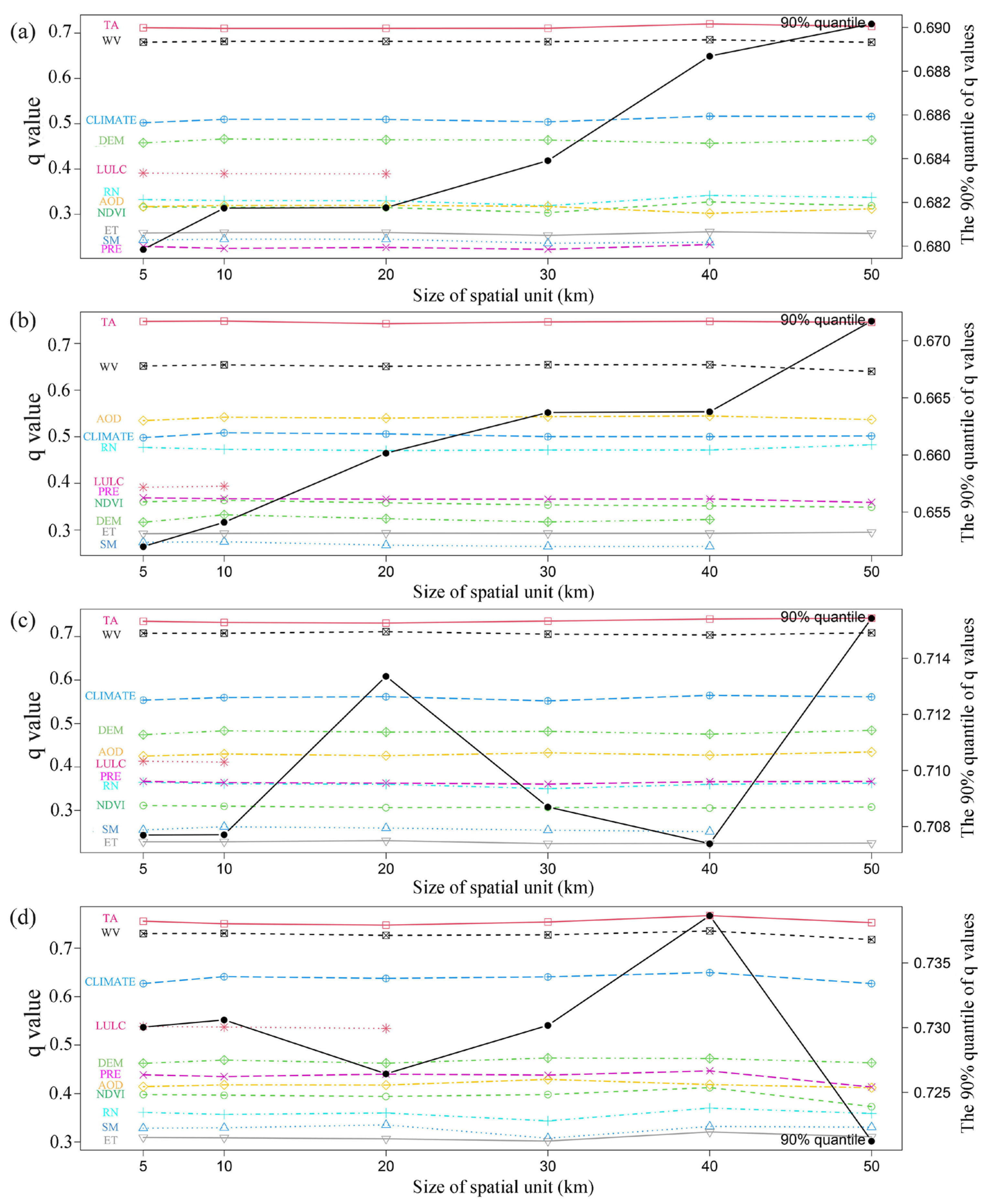
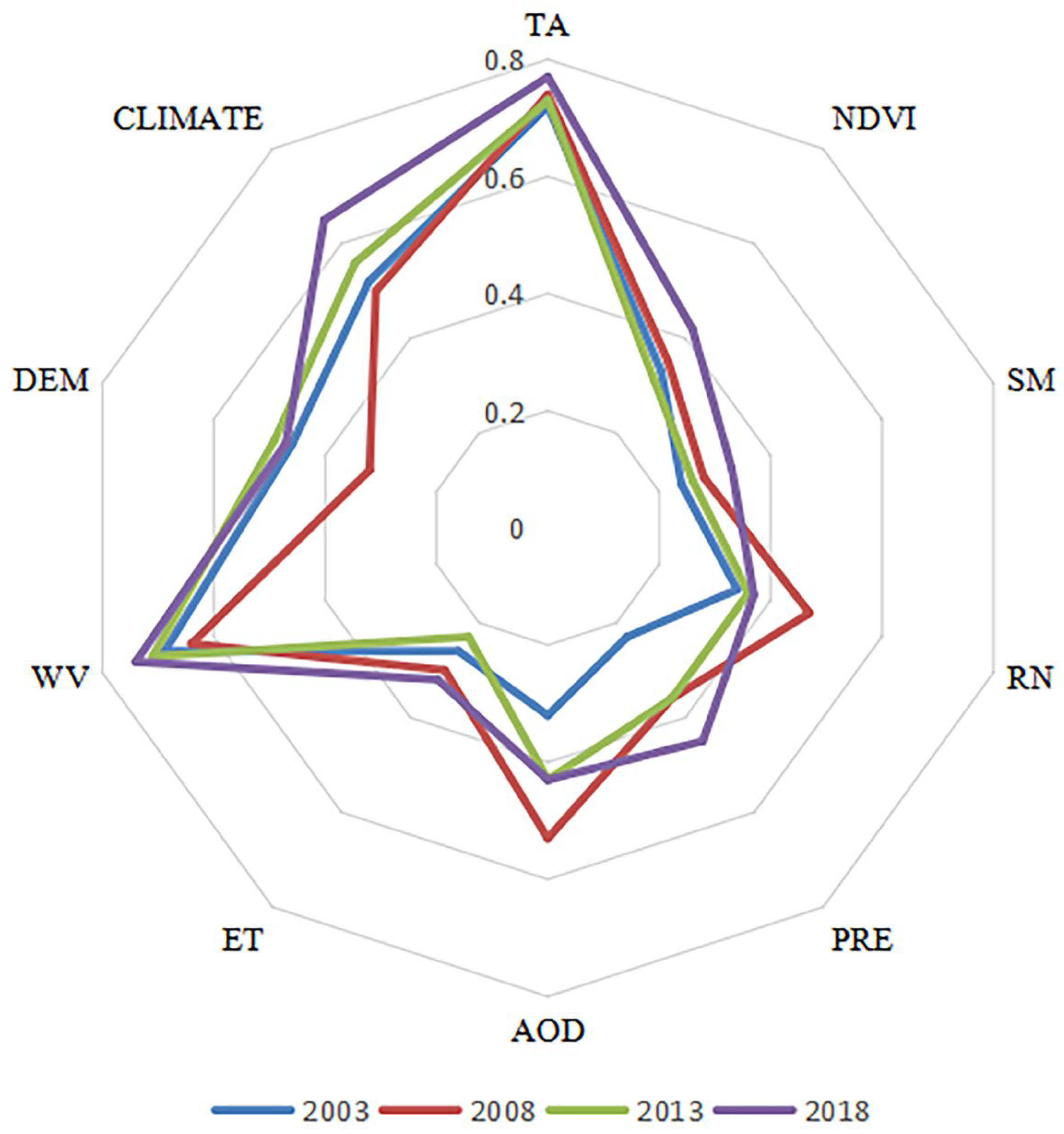

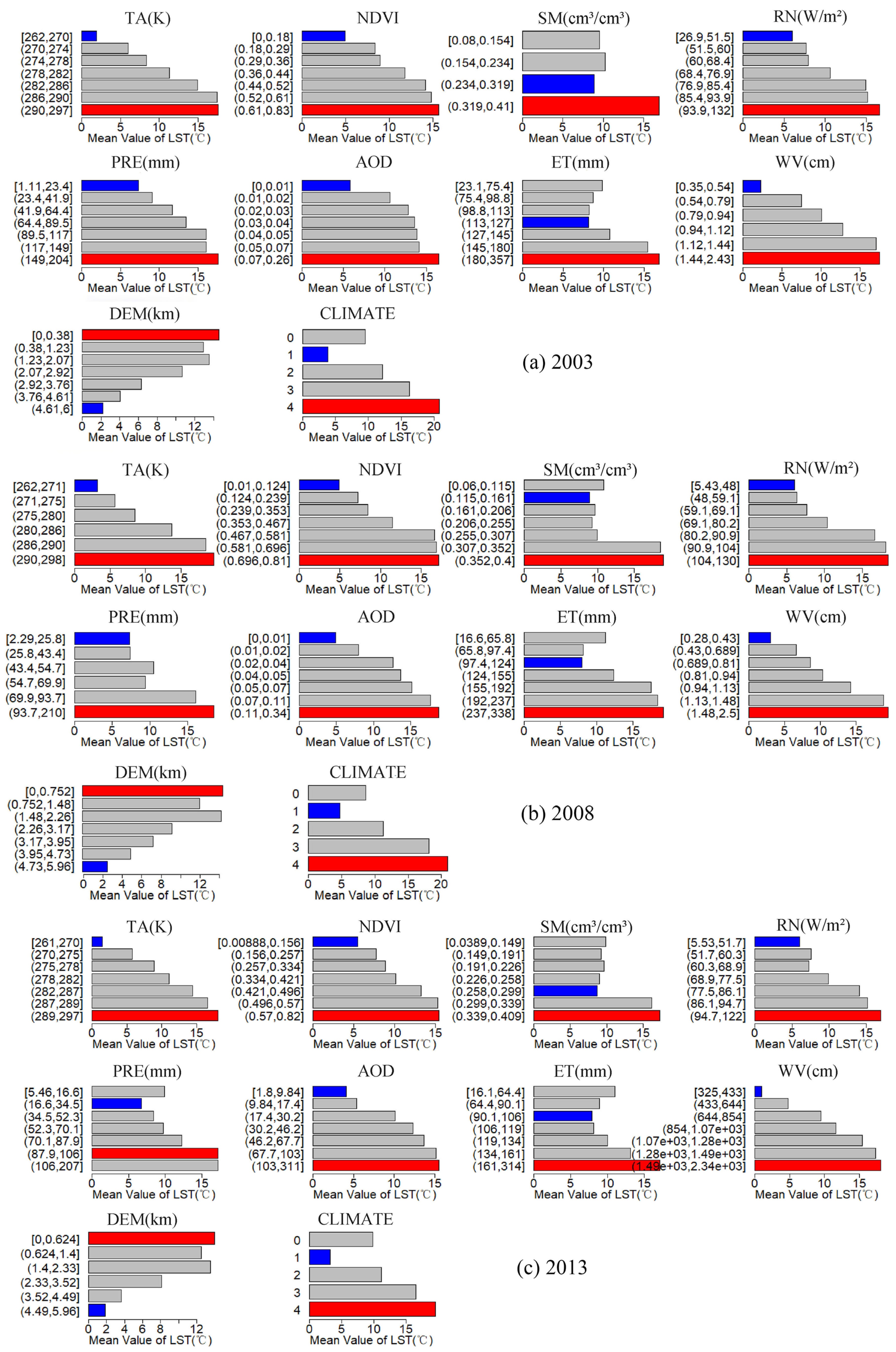
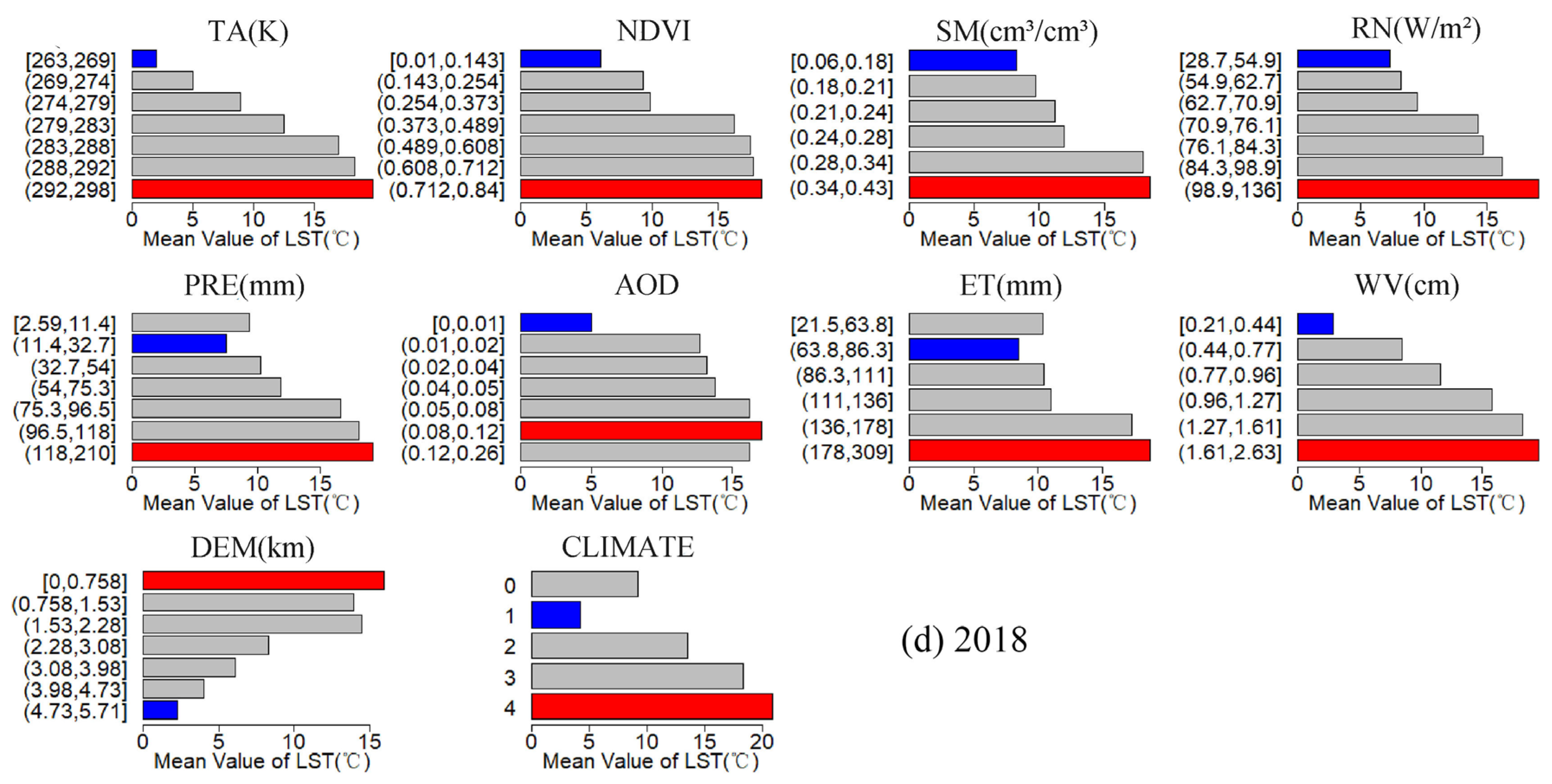
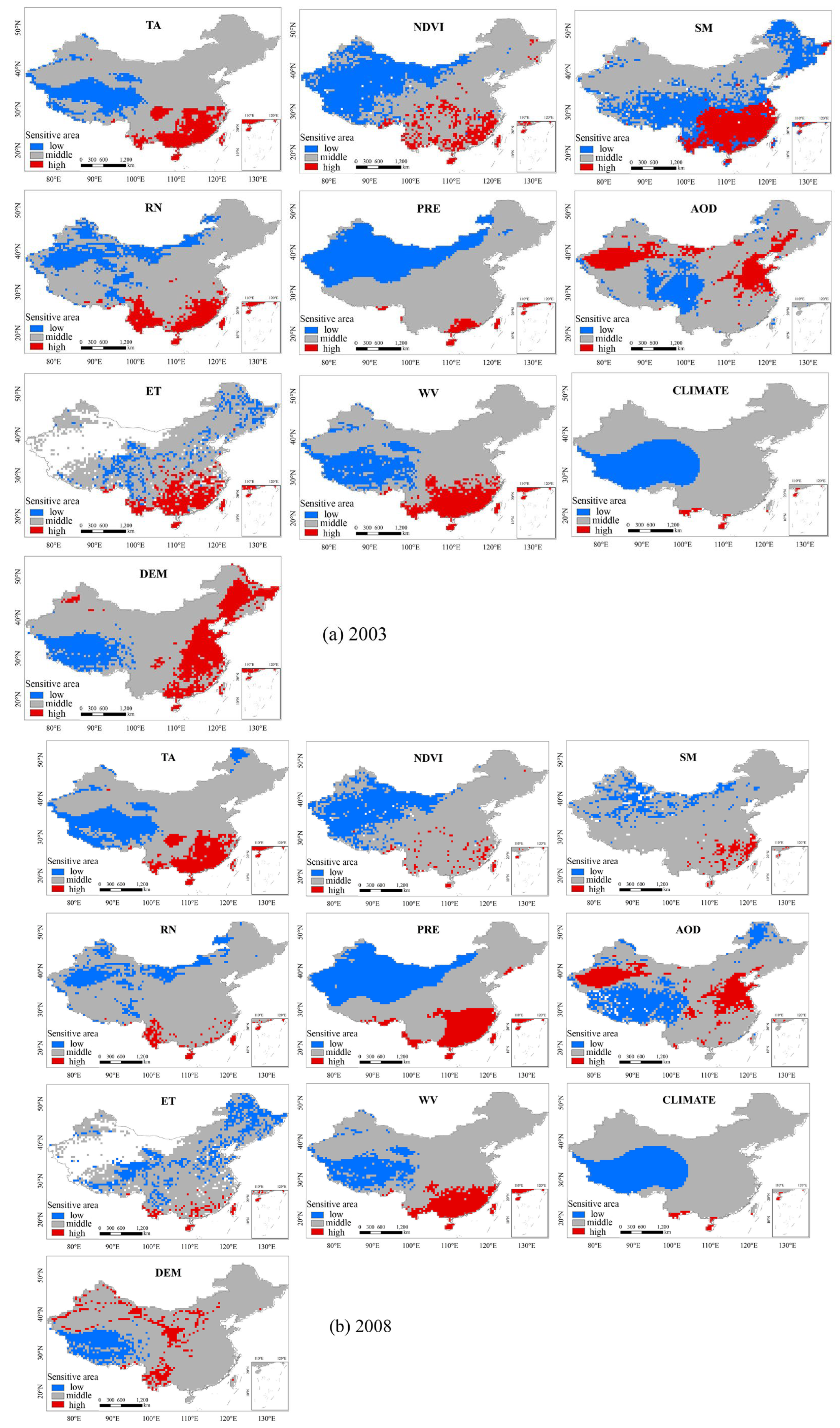
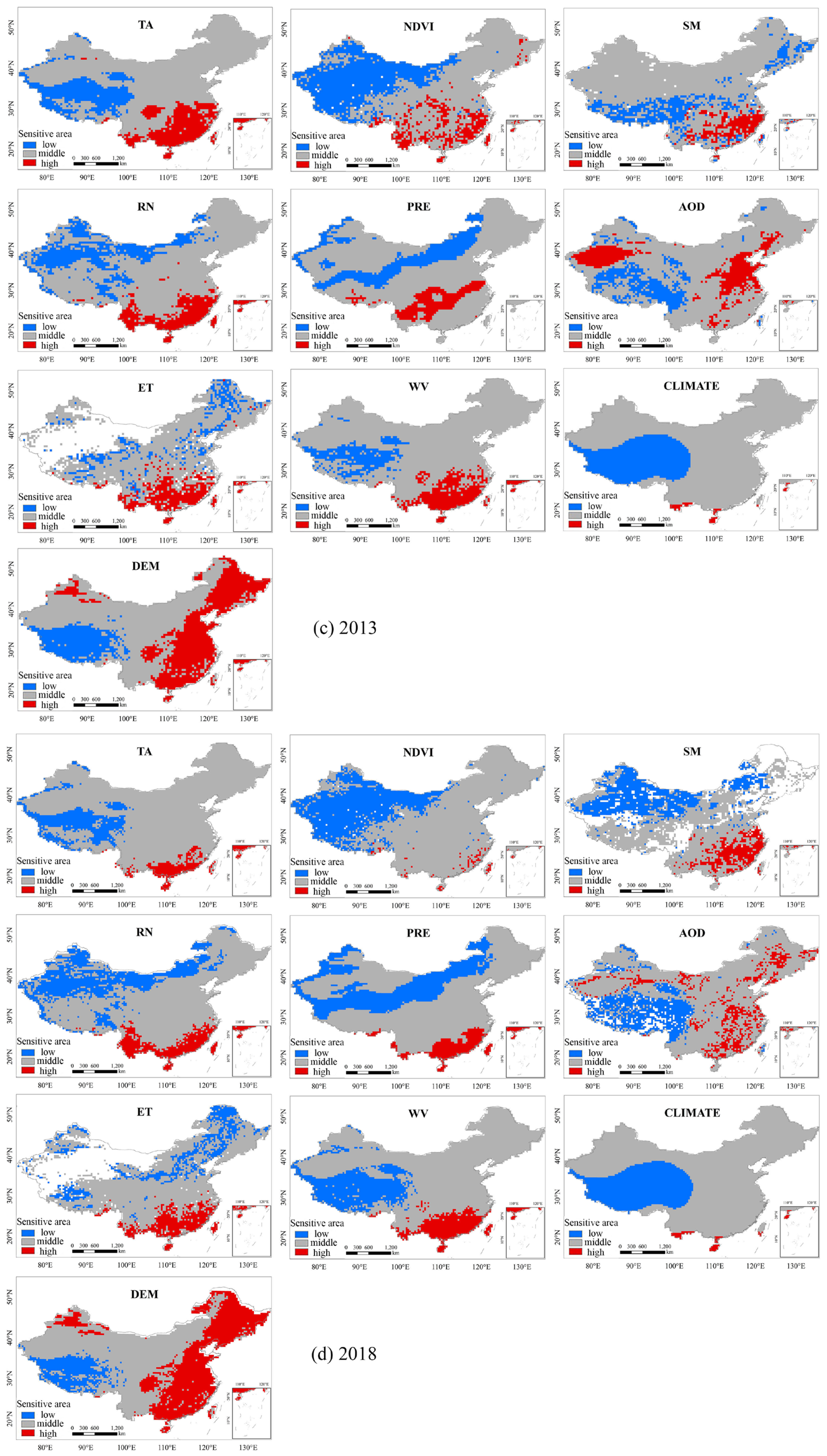
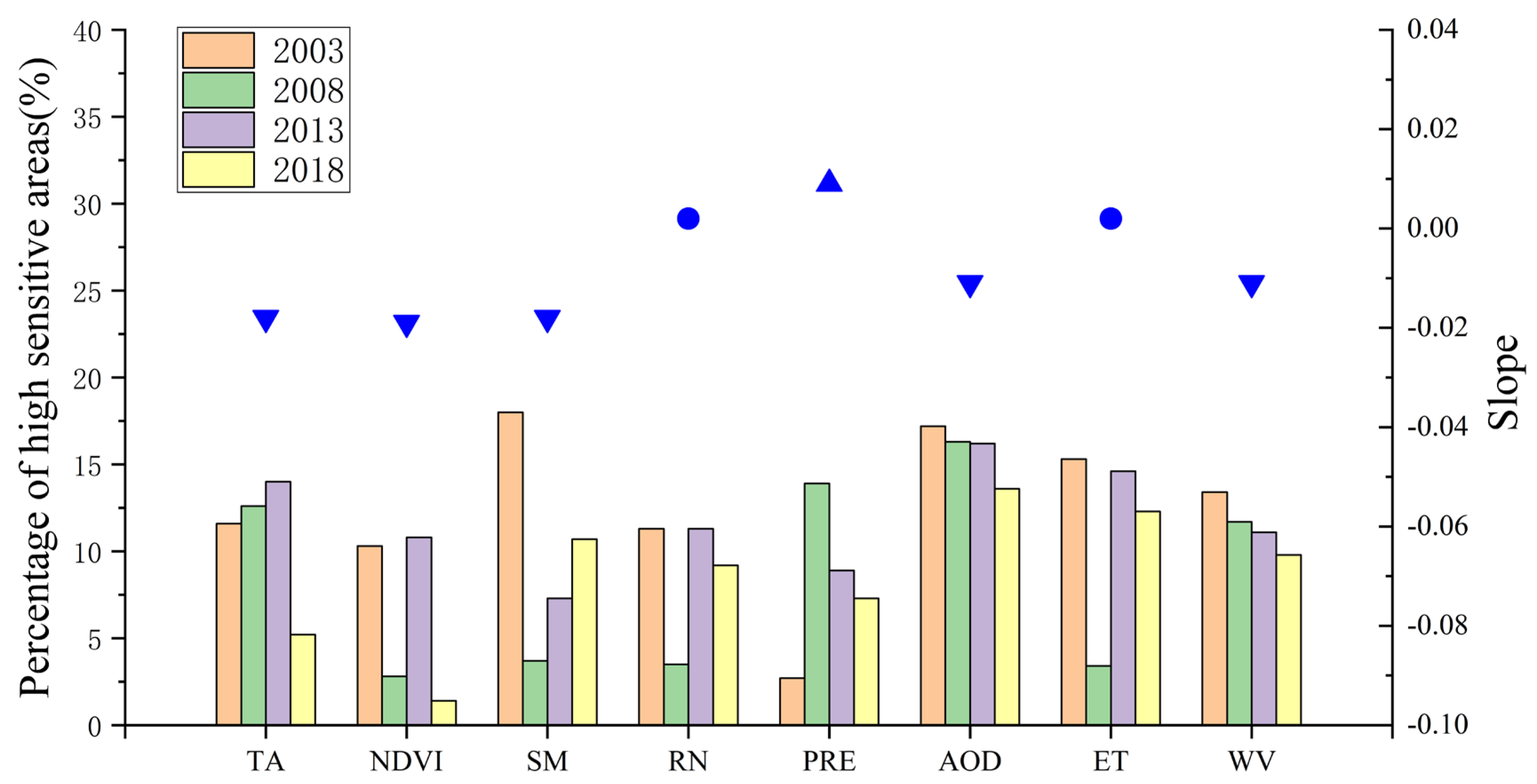
| Judgment Criteria | Interaction Type |
|---|---|
| q(X1∩X2) = q(X1) + q(X2) | Independent |
| q(X1∩X2) > q(X1) + q(X2) | Nonlinear enhance |
| q(X1∩X2) < Min(q(X1), q(X2)) | Nonlinear weaken |
| Min(q(X1), q(X2)) < q(X1∩X2) < Max(q(X1), q(X2)) | Univariate weaken |
| q(X1∩X2) > Max(q(X1), q(X2)) | Bivariate enhance |
| Variables | TA(K) | NDVI | SM(cm3/cm3) | RN(W/cm2) | PRE(mm) | AOD | ET(mm) | WV(cm) | DEM(km) |
|---|---|---|---|---|---|---|---|---|---|
| Discretization Methods | SD | NB | SD | SD | QU | QU | QU | SD | NB |
| Discrete interval | 262.49 | 0.00 | 0.08 | 26.93 | 1.11 | 0.00 | 23.05 | 0.35 | 0.00 |
| 269.69 | 0.17 | 0.18 | 51.47 | 22.83 | 0.01 | 75.43 | 0.48 | 539.69 | |
| 273.83 | 0.30 | 0.21 | 59.95 | 32.30 | 0.02 | 98.81 | 0.69 | 1262.52 | |
| 277.97 | 0.41 | 0.24 | 68.43 | 42.14 | 0.02 | 113.31 | 0.90 | 2199.13 | |
| 282.12 | 0.52 | 0.28 | 76.91 | 61.66 | 0.03 | 126.64 | 1.10 | 3403.75 | |
| 286.26 | 0.64 | 0.31 | 85.39 | 93.01 | 0.04 | 145.09 | 1.31 | 4545.05 | |
| 290.40 | 0.83 | 0.34 | 93.87 | 203.67 | 0.06 | 180.45 | 1.52 | 6000.00 | |
| 297.44 | 0.41 | 132.29 | 0.26 | 357.08 | 2.43 |
| Variables | TA(K) | NDVI | SM(cm3/cm3) | RN(W/cm2) | PRE(mm) | AOD | ET(mm) | WV(cm) | DEM(km) |
|---|---|---|---|---|---|---|---|---|---|
| Discretization Methods | NB | EI | SD | QU | QU | QU | QU | QU | NB |
| Discrete interval | 261.75 | 0.01 | 0.04 | 9.46 | 3.99 | 0.00 | 15.33 | 0.26 | 0.00 |
| 268.24 | 0.12 | 0.17 | 53.08 | 25.64 | 0.01 | 75.52 | 0.43 | 565.33 | |
| 272.65 | 0.24 | 0.20 | 61.58 | 42.41 | 0.01 | 94.71 | 0.69 | 1244.37 | |
| 276.80 | 0.36 | 0.23 | 72.70 | 53.63 | 0.03 | 109.64 | 0.81 | 2186.64 | |
| 281.60 | 0.48 | 0.26 | 84.03 | 68.84 | 0.04 | 124.11 | 0.94 | 3326.08 | |
| 286.17 | 0.60 | 0.30 | 93.52 | 92.09 | 0.07 | 141.82 | 1.13 | 4465.60 | |
| 290.81 | 0.71 | 0.33 | 135.44 | 210.34 | 0.11 | 175.99 | 1.48 | 5864.00 | |
| 297.18 | 0.83 | 0.40 | 0.35 | 357.94 | 2.54 |
| Variables | TA(K) | NDVI | SM(cm3/cm3) | RN(W/cm2) | PRE(mm) | AOD | ET(mm) | WV(cm) | DEM(km) |
|---|---|---|---|---|---|---|---|---|---|
| Discretization Methods | SD | QU | NB | NB | SD | QU | SD | SD | NB |
| Discrete interval | 259.93 | 0.00 | 0.04 | 9.92 | 5.06 | 0.00 | 14.24 | 0.30 | −89.00 |
| 269.88 | 0.16 | 0.15 | 46.41 | 16.22 | 0.01 | 56.65 | 0.43 | 508.09 | |
| 273.92 | 0.26 | 0.19 | 58.45 | 33.84 | 0.02 | 79.79 | 0.65 | 1241.16 | |
| 277.97 | 0.34 | 0.23 | 67.86 | 51.46 | 0.03 | 102.93 | 0.86 | 2274.81 | |
| 282.01 | 0.42 | 0.26 | 77.90 | 69.07 | 0.05 | 126.07 | 1.07 | 3503.69 | |
| 286.06 | 0.49 | 0.30 | 88.97 | 86.69 | 0.07 | 149.21 | 1.28 | 4616.17 | |
| 290.10 | 0.58 | 0.34 | 100.88 | 104.31 | 0.10 | 172.35 | 1.49 | 6030.00 | |
| 297.32 | 0.87 | 0.41 | 137.66 | 212.16 | 0.33 | 373.79 | 2.46 |
| Variables | TA(K) | NDVI | SM(cm3/cm3) | RN(W/cm2) | PRE(mm) | AOD | ET(mm) | WV(cm) | DEM(km) |
|---|---|---|---|---|---|---|---|---|---|
| Discretization Methods | NB | NB | SD | QU | SD | QU | QU | QU | NB |
| Discrete interval | 263.11 | 0.01 | 0.06 | 28.68 | 2.59 | 0 | 21.47 | 0.21 | 0.00 |
| 269.56 | 0.16 | 0.15 | 54.86 | 11.39 | 0.01 | 63.81 | 0.44 | 624.20 | |
| 274.15 | 0.27 | 0.22 | 62.68 | 32.68 | 0.03 | 86.28 | 0.77 | 1388.16 | |
| 278.74 | 0.36 | 0.29 | 70.94 | 53.97 | 0.06 | 111.19 | 0.96 | 2393.28 | |
| 283.55 | 0.45 | 0.35 | 76.10 | 75.25 | 0.10 | 135.76 | 1.27 | 3496.70 | |
| 287.80 | 0.55 | 0.43 | 84.31 | 96.54 | 0.26 | 178.07 | 1.61 | 4495.55 | |
| 291.64 | 0.65 | 98.87 | 117.83 | 308.53 | 2.63 | 5710.00 | |||
| 298.42 | 0.84 | 135.60 | 209.62 |
| q-Value | |||||
|---|---|---|---|---|---|
| 2003 | 2008 | 2013 | 2018 | slope | |
| TA | 0.72 | 0.74 | 0.73 | 0.77 | 0.003 |
| NDVI | 0.33 | 0.35 | 0.31 | 0.42 | 0.005 |
| SM | 0.24 | 0.28 | 0.26 | 0.33 | 0.005 |
| RN | 0.34 | 0.47 | 0.36 | 0.37 | 0.000 |
| PRE | 0.23 | 0.36 | 0.36 | 0.45 | 0.013 |
| AOD | 0.32 | 0.53 | 0.43 | 0.43 | 0.005 |
| ET | 0.26 | 0.30 | 0.23 | 0.32 | 0.002 |
| WV | 0.69 | 0.64 | 0.71 | 0.74 | 0.004 |
| LULC | Non-significant | ||||
| DEM | 0.46 | 0.32 | 0.49 | 0.47 | 0.004 |
| CLIMATE | 0.52 | 0.50 | 0.56 | 0.65 | 0.009 |
Disclaimer/Publisher’s Note: The statements, opinions and data contained in all publications are solely those of the individual author(s) and contributor(s) and not of MDPI and/or the editor(s). MDPI and/or the editor(s) disclaim responsibility for any injury to people or property resulting from any ideas, methods, instructions or products referred to in the content. |
© 2023 by the authors. Licensee MDPI, Basel, Switzerland. This article is an open access article distributed under the terms and conditions of the Creative Commons Attribution (CC BY) license (https://creativecommons.org/licenses/by/4.0/).
Share and Cite
Yu, Y.; Fang, S.; Zhuo, W. Revealing the Driving Mechanisms of Land Surface Temperature Spatial Heterogeneity and Its Sensitive Regions in China Based on GeoDetector. Remote Sens. 2023, 15, 2814. https://doi.org/10.3390/rs15112814
Yu Y, Fang S, Zhuo W. Revealing the Driving Mechanisms of Land Surface Temperature Spatial Heterogeneity and Its Sensitive Regions in China Based on GeoDetector. Remote Sensing. 2023; 15(11):2814. https://doi.org/10.3390/rs15112814
Chicago/Turabian StyleYu, Yanru, Shibo Fang, and Wen Zhuo. 2023. "Revealing the Driving Mechanisms of Land Surface Temperature Spatial Heterogeneity and Its Sensitive Regions in China Based on GeoDetector" Remote Sensing 15, no. 11: 2814. https://doi.org/10.3390/rs15112814
APA StyleYu, Y., Fang, S., & Zhuo, W. (2023). Revealing the Driving Mechanisms of Land Surface Temperature Spatial Heterogeneity and Its Sensitive Regions in China Based on GeoDetector. Remote Sensing, 15(11), 2814. https://doi.org/10.3390/rs15112814








